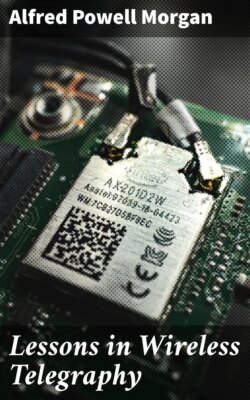Читать книгу Lessons in Wireless Telegraphy - Alfred Powell Morgan - Страница 8
На сайте Литреса книга снята с продажи.
LESSON FIVE. ELECTROMAGNETISM.
ОглавлениеTable of Contents
The Electromagnet. The Solenoid.
If a current of electricity is passed through a copper wire, the wire will attract to itself iron filings, etc., as long as the current continues to flow. There is then a magnetic field around the wire. As soon as the current is shut off the filings drop away because the field immediately disappears with the cessation of the current.
FIG. 13. Magnetic Phantom about a Wire Carrying Current.
The lines of force flow around the wire in a circle. The circular lines of the field of force surrounding a straight wire may be shown by passing a wire vertically through a hole in the centre of a horizontal card. Iron filings are sifted over the card and a strong current passed through the wire. On tapping the card gently, the filings near the wire set themselves in concentric circles round it.
The creation of a magnetic field by a conductor in its own neighborhood when carrying a current of electricity is one of the most important phenomena of electrical science.
Electrical energy must be expended in producing a magnetic field. When a current of electricity is turned on in a wire the magnetic field grows around the wire, some of the energy of the current being used for the building process.
This reactive effect of the surrounding magnetic field is one reason why electric currents do not instantly rise to their full value.
FIG. 14. Diagram showing how Lines of Force Form about a Loop of Wire.
If a wire is connected to a battery or some other source of electric current and a portion of the circuit twisted so as to form a loop, the entire space enclosed by the loop will be a magnetic field and possess magnetic properties.
By forming a wire into a spiral coil the combined effect of each individual turn is concentrated in a small space and a powerful field of force is produced. If the coil is provided with an iron core, the lines of force can be concentrated and will exercise a very powerful attractive effect upon any neighboring masses of iron or steel. Such a coil is called an electromagnet. A hollow coil without any core is called a solenoid.
FIG. 15. Magnetic Phantom about a Coil of Wire.
Solenoids and electromagnets play a very important part in the construction of most electrical instruments.
The strength of an electromagnetic coil is proportional to its ampere turns. The ampere turns of a coil are obtained by multiplying the number of amperes flowing through the coil by the number of turns of wire composing it.
